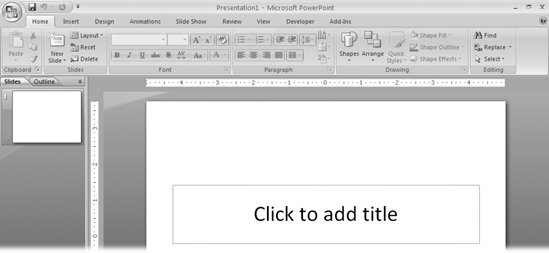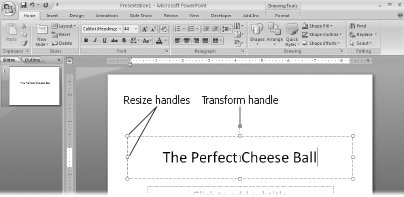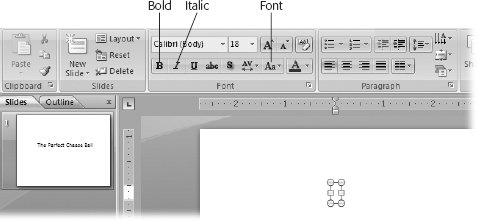1.3. Adding Text You'll want to add at least some text to most, if not all, PowerPoint presentations you create. (See the box on page 36 for advice on how much prose to add to your presentation.) Knowing that, the PowerPoint designers made it easy for you to add text to your slides. The following sections show you how. 1.3.1. Adding Text to an Existing Text Box When you start to work with a new presentation, the ribbon displays the Home tab, which should look somewhat familiar if you've used PowerPoint 2003 (Figure 1-13).  | Figure 1-13. Until you click a text box, most of the text- related options appear grayed out, meaning you can't use them. See Figure 1-14 for a glimpse of the subtitle box. | |
Blank presentations come complete with title and subtitle placeholder text boxes. To replace the placeholder text in either of these two text boxes with your own text, simply click inside the placeholder and begin typing. When you do, two things happen: -
PowerPoint displays the Drawing Tools Format tab and, on the Home ribbon, activates many of the text formatting options (Figure 1-14). You can use these options to change the font, size , and color of your text, turn your text into a right-justified paragraph or a bullet point, and much more. (Chapter 3 describes your options in detail.) -
Resize and transform handles appear at the corners and edges of the text box (Figure 1-14). Tiny white resize handles , which are square on the edges of the text box and circular on the corners, let you stretch or shrink your text box by dragging them. The circular green transform handle appears above the top of your text box and lets you tilt it. Drag the handles to tilt or resize your text box.  | Figure 1-14. As soon as you click a text box, PowerPoint activates the text formatting and drawing tools and reveals the Drawing Tools Format tab. Now, in addition to typing your text, you can format it, change its color, or add an effect (such as a glow or bevel). Drag any of the eight white resize handles to resize your text box; drag the circular green transform handle to rotate the text box. Chapter 3 covers text manipulation in more detail. | |
1.3.2. Adding a New Text Box You're not limited to the placeholder text boxes PowerPoint starts you off with: you can add as many additional text boxes to your slides as you like.
Note: Chapter 3 shows you how to format text boxes, as well as the text inside them. Chapter 5 shows you how to add placeholder text boxes to slide masters.
DESIGN TIME
The Evils (or Not) of Text | | There are two schools of thought when it comes to using text in PowerPoint presentations. One says text is king; the other advises PowerPointers to use as little text as possible. Here's the rationale for each approach: -
Text rulesalways has, always will. According to the more-bullets-the-better crowd , a presentation is text. Period. It's how we think, it's what we're used to, and it helps us organize our thoughts, reactions , and questions. Folks who subscribe to this approach may quibble about the number of words an effective bullet point should be limited to (the number five comes up a lot), and whether to put the most important bullets at the beginning of the presentation or at the end; but the focus is always on hownot whetherto use text. -
Text distracts. The other school of thought is that it is nearly impossible for audiences to read more than a couple of words on a slide, even if they're sitting up front and wearing their glasses . And if your audience does read your slides, that means they are busy reading and forming opinions instead of paying attention to the actual presentation (which is you ). According to these folks, using a lot of text results in lazily constructed , ineffective , and boring brain-dumps-disguised-as-presentations. These folks believe the best use of PowerPoint is carefully chosen charts , graphs, and worth-a-thousand-word pictures. The theory is that pictures pique your audience's curiosity without satisfying it: your audience has to listen to you for explanation and clarification . (And you can always give them handouts containing those all-important bullet points after the show, if you must.) So which approach should you take? It depends. In a perfect world, you'd have time to find or create super-compelling graphics and animations that beautifully complement your presentation. You'd deliver the message of your presentation by engaging your audience with your wit, knowledge, body language, and persuasive powers. You'd use text sparingly and appropriately: to pose questions (which you'd answer in your talk) and to hammer home main points. But not everyone's comfortable with this freewheeling presentation style. Plus it's a lot more work (which explains why most of the PowerPoint presentations you've sat through in your life have been riddled with bullet points). And in some casesacademic lectures, for exampleusing text as a springboard for discussion and audience note-taking just makes more sense. Ultimately, you get to make the call. As long as you choose an approach that supports your presentation goals, you're golden. |
To add a new text box to a slide: -
Click the Insert tab. The Insert ribbon (Figure 1-15) appears.  | Figure 1-15. As you can see in the Text section of the Insert ribbon, PowerPoint makes it easy to add not just text boxes, but headers, footers, date- and timestamps, and more. | | -
On the Insert ribbon, click Text Box. In the status bar at the bottom of the screen, PowerPoint displays a helpful hint ("Click and drag to insert a text box"). When you mouse over your slide, you notice that your cursor looks like a tiny down arrow. -
On the slide, click where you want your new text box to appear. A text box appears with the cursor handily positioned inside (Figure 1-16). The Drawing Tools Format tab pops up, and on the Home ribbon, PowerPoint activates most of the formatting options, ready for you to format your text.  | Figure 1-16. Choosing one or more formatting options (such as Bold, Italics, or Font) before you begin typing tells PowerPoint to apply those options to your text automatically as you type. (You'll find more on formatting in Chapter 3.) | |
Note: Alternatively, you can click and drag to draw the outline of your text box before you begin typing. It's another step, but it'll help you get an idea of how much space your text will take up on your slide before you actually type it in.
-
Type your text. The text box expands automatically to accommodate your text.
Note: In addition to adding text directly to your slides, as shown here, you can also paste or type text onto shapes (for example, a Stop sign). Chapter 9 shows you how.
DESIGN TIME
Using Text Effectively | | If you choose to include text in your presentation, then keep these tips in mind: -
Distill . Your audience's eyes will glaze over if you hit them with a barrage of text on every slide, so you want to distill your message into as few words as possible. (Three to six bullets and a dozen or so words per slide is a good guideline.) In other words, reserve text for the few salient points you want your audience to take home with them. When you need back-up documentation, examples, supporting facts and figures, and so on, distribute hard-copy handoutsdon't try to cram the information onto your slides. -
Carefully consider word placement . The Space Shuttle Columbia disaster a few years back put PowerPoint in the limelight for a sobering reason: In a PowerPoint presentation delivered to NASA officials before the disaster, engineers mentioned the problem that, ultimately, contributed to the tragic breakup of the shuttle over Texas in 2003. But the crucial information was buried in an avalanche of bullet points near the end of a long presentation, and none of the decision- makers in the audience realized its significance. Your presentation may not address life-and-death issues, but you still want to reserve the first and last slides of your presentation for critical information. |
|



